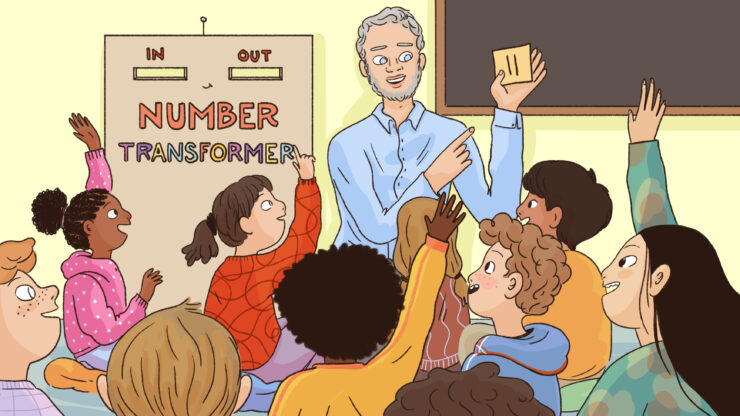The psychologist connecting the dots between spatial thinking and STEM learning
Zachary Hawes studies how spatial thinking makes abstract ideas accessible

Zachary Hawes was training to be a teacher when he noticed how central spatial thinking is to mathematics. He now studies how schools can help students strengthen spatial thinking skills in the classroom. Aisha Schnellmann finds out more.
Aisha Schnellmann: Why are you studying spatial thinking?
Zachary Hawes: Whether we realize it or not, spatial thinking is woven into our daily lives: when we pack a suitcase, navigate an unfamiliar city, or organise our homes. We don’t just use space in the physical sense; we use our minds as a mental space to organize, create, and play with ideas – about the past, present, and future. Spatial thinking is a fundamental, yet often neglected, aspect of human cognition.
“Spatial thinking is a fundamental, yet often neglected, aspect of human cognition.”
Much of my research focuses on the role of spatial thinking in learning, particularly in mathematics. In the classroom, spatial thinking makes abstract ideas more accessible. For example, when students tackle a mathematical word problem, they often start by mentally visualizing the scenario. They focus on the key details, perhaps sketching a diagram to work through the problem. Externalizing this thought process through diagrams reduces the cognitive load and creates a bridge between the abstract and the concrete.
Right now, I’m particularly excited about exploring the interplay between internal and external visualization and its role in learning mathematics.
AS: How did you become interested in spatial thinking and learning?
ZH: My career path was shaped by a serendipitous coalescence of many factors – mentors, unexpected opportunities, and luck. My interest in psychology actually started with an interest in language and its role in thought. However, my focus soon shifted to spatial thinking while I was working as a research assistant (largely by chance!) on a project exploring young children’s algebra learning. Through this project I first got a glimpse of just how much spatial thinking is involved in mathematics – something that had never occurred to me before.
At the same time, I was training to become a teacher. Through this dual role as researcher and teacher, it became very clear to me that there was a large gap between research and practice. While the cognitive and learning sciences have made it clear that spatial thinking is fundamental to learning, I saw little to no attention being paid to spatial thinking in the classroom. Any attention to spatial thinking was implicit, and yet, as I looked, I started seeing it everywhere – in drawings, manipulatives, gestures, and textbooks. Fast forward 15 years, and I’m just as interested, if not more, in understanding the role of spatial thinking in learning and its applications to education.
AS: How will your research help children?
ZH: Deepening our understanding of spatial thinking makes us better equipped to harness its potential and support children in developing the skills they need to adapt and thrive – no matter what challenges come their way. For example, there are strong links between spatial thinking and performance in mathematics and science. When we understand this connection more clearly, we can design assessments and instruction that better support learning in these crucial areas.
In essence, spatial thinking is an adaptive set of skills; the more we can learn about how it supports learning, creativity, and problem solving, the better able we’ll be to leverage its potential across educational, occupational, and ever-changing contexts. Spatial thinking has helped humans adapt and evolve for centuries. As our world becomes increasingly technologically advanced and data-dependent, spatial thinking is likely to become an even more valuable skillset.
“Spatial thinking has helped humans adapt and evolve for centuries.”
AS: Has working in this field changed anything in your work or home life?
ZH: Definitely. Studying spatial thinking has had a profound impact on how I see and interact within the world. In both my teaching and writing, I regularly draw on what I’ve learned about the use of visual-spatial representations to support understanding and communication. I’m always challenging myself to turn words into images. Compared with linear text, images can capture relationships between ideas in a more direct and memorable way.
In my daily life, I now notice spatial reasoning everywhere. I see it in how my kids play, in the arts, in routine household activities such as cooking, in the way we interpret board game instructions, or any instructions! Perhaps most prominently, I see it in human design and innovations like maps, graphs, zippers, and bikes.
AS: What ideas are you pursuing next?
ZH: I’m really excited to dig deeper into why, when, and how spatial reasoning supports mathematical thinking. We’ve known for over a century that there’s a connection between spatial thinking and mathematical abilities, but only recently have researchers begun to uncover the mechanisms that explain this relationship.
“We’ve known for over a century that there’s a connection between spatial thinking and mathematical abilities.”
I’ve become increasingly fascinated by the interplay between internal and external visualizations. How does what we see – or struggle or fail to see – with the ‘mind’s eye’ relate to what we are able to express externally through drawings, models, or manipulatives? To explore this question, our lab is currently designing a study to investigate how children’s spatial visualization skills relate to their use of external visual-spatial representations when solving mathematical problems.
On a more practical level, I’m eager to continue bridging the gap between research and practice. I plan to work with teachers to design new spatial learning games and activities that are easy to integrate into the classroom, and that offer rich, engaging opportunities for children to strengthen their spatial thinking skills. Ultimately, I hope my research will contribute to a growing body of research and public recognition of the importance of spatial thinking in our educational systems and beyond.
Footnotes
Zachary Hawes is an Assistant Professor in the Department of Applied Psychology and Human Development at the Ontario Institute for Studies in Education, University of Toronto, where he leads the Mathematical Thinking Lab. His primary research interests involve studying the relationship between spatial thinking and mathematics (and the other STEM disciplines) and finding ways to use what he has learned to design more accessible and engaging learning opportunities. He is a 2024-2026 Jacobs Foundation Research Fellow.
Lab website, University of Toronto profile, Bluesky profile
This interview has been edited for clarity.

